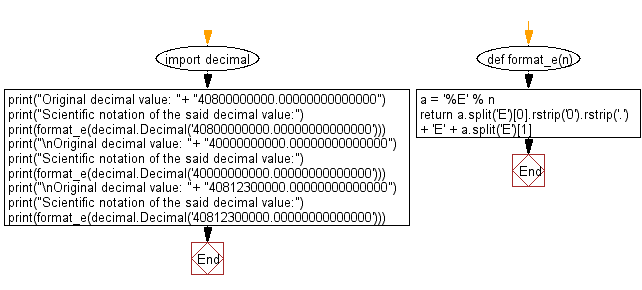Python: Display a given decimal value in scientific notation
Python module: Exercise-7 with Solution
Write a Python program to display a given decimal value in scientific notation. Use decimal.Decimal
Sample Solution:
Python Code:
import decimal
#Source: https://bit.ly/2SfZEtL
def format_e(n):
a = '%E' % n
return a.split('E')[0].rstrip('0').rstrip('.') + 'E' + a.split('E')[1]
print("Original decimal value: "+ "40800000000.00000000000000")
print("Scientific notation of the said decimal value:")
print(format_e(decimal.Decimal('40800000000.00000000000000')))
print("\nOriginal decimal value: "+ "40000000000.00000000000000")
print("Scientific notation of the said decimal value:")
print(format_e(decimal.Decimal('40000000000.00000000000000')))
print("\nOriginal decimal value: "+ "40812300000.00000000000000")
print("Scientific notation of the said decimal value:")
print(format_e(decimal.Decimal('40812300000.00000000000000')))
Sample Output:
Original decimal value: 40800000000.00000000000000 Scientific notation of the said decimal value: 4.08E+10 Original decimal value: 40000000000.00000000000000 Scientific notation of the said decimal value: 4E+10 Original decimal value: 40812300000.00000000000000 Scientific notation of the said decimal value: 4.08123E+10
Flowchart:

Visualize Python code execution:
The following tool visualize what the computer is doing step-by-step as it executes the said program:
Python Code Editor:
Have another way to solve this solution? Contribute your code (and comments) through Disqus.
Previous: Write a Python program to configure the rounding to round to the nearest, with ties going to the nearest even integer.
Next: Python built-in Modules Exercise Home.
What is the difficulty level of this exercise?
Test your Programming skills with w3resource's quiz.
Python: Tips of the Day
Find current directory and file's directory:
To get the full path to the directory a Python file is contained in, write this in that file:
import os dir_path = os.path.dirname(os.path.realpath(__file__))
(Note that the incantation above won't work if you've already used os.chdir() to change your current working directory, since the value of the __file__ constant is relative to the current working directory and is not changed by an os.chdir() call.)
To get the current working directory use
import os cwd = os.getcwd()
Documentation references for the modules, constants and functions used above:
- The os and os.path modules.
- The __file__ constant
- os.path.realpath(path) (returns "the canonical path of the specified filename, eliminating any symbolic links encountered in the path")
- os.path.dirname(path) (returns "the directory name of pathname path")
- os.getcwd() (returns "a string representing the current working directory")
- os.chdir(path) ("change the current working directory to path")
Ref: https://bit.ly/3fy0R6m
- New Content published on w3resource:
- HTML-CSS Practical: Exercises, Practice, Solution
- Java Regular Expression: Exercises, Practice, Solution
- Scala Programming Exercises, Practice, Solution
- Python Itertools exercises
- Python Numpy exercises
- Python GeoPy Package exercises
- Python Pandas exercises
- Python nltk exercises
- Python BeautifulSoup exercises
- Form Template
- Composer - PHP Package Manager
- PHPUnit - PHP Testing
- Laravel - PHP Framework
- Angular - JavaScript Framework
- Vue - JavaScript Framework
- Jest - JavaScript Testing Framework
